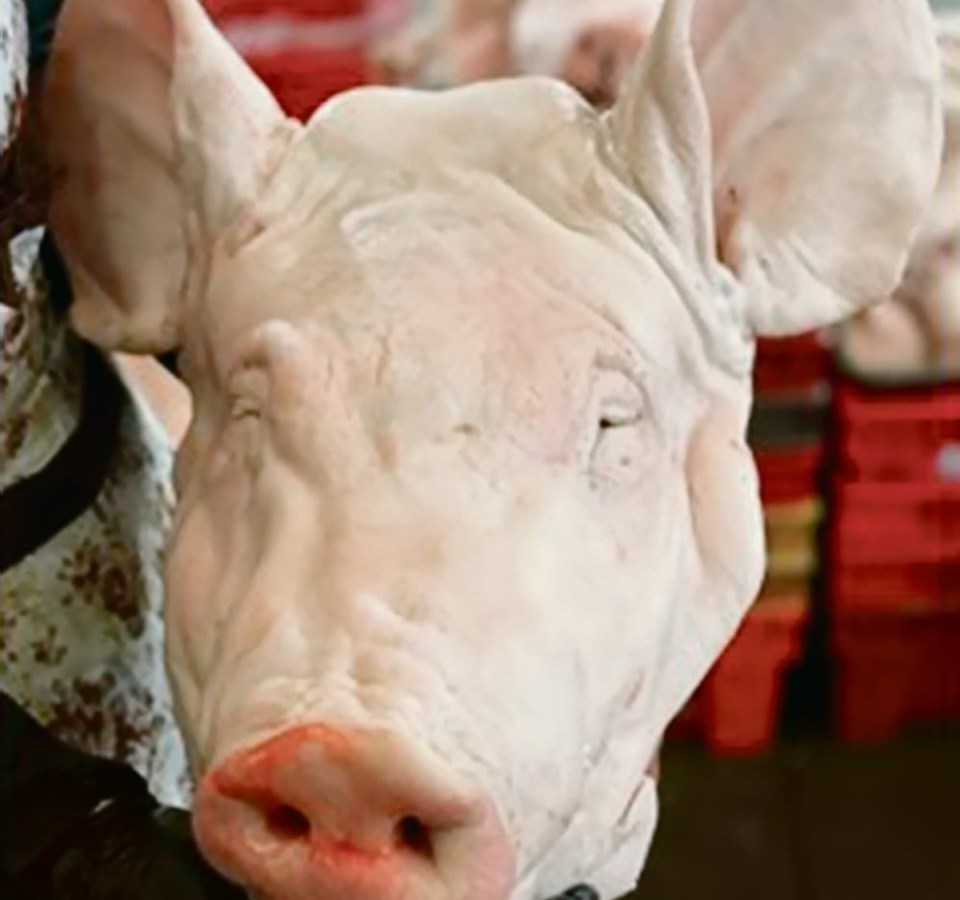WESTERN PRODUCER — The pig’s head is impressive: those wing-like ears that make one question the skeptical saying about “when pigs fly,” that sensitive snout, the flat forehead that protects a prodigious intelligence, those squinty eyes that remind one of Lyle Van Cleef, those muscular cheeks.
All this beauty is lost on 90 per cent of Canadians and Americans, who view a severed swine head with horror and perhaps a thing of satanic worship. The Chinese are smarter about this. A pig’s head, or many of them, are a common sight in China’s butcher shops and markets.
Chinese restaurant cooks, as well as most traditional mothers and grandmothers, know how to take the pig’s head and use its cartilaginous ears and snout, its meaty cheeks and its fat, skin and bones to produce fresh and unique tastes.
The head is just one of numerous parts of the pig carcass that generally don’t find much value in the North American market. Much of what we see as offal, and treat as if it’s awful, is valued in various places overseas, where we can ship it and make at least some money so long as the freight bill isn’t too high.
The same applies to cattle carcasses. Much of that giant collection of meat, bone, cartilage and soft tissue ends up being ground, exported as offal or rendered.
Ground beef and ground pork are sold for decent money in North American grocery stores, but it’s safe to assume that some of the cuts of meat that are ground today would be worth considerably more if they were sold as specific cuts.
However, many of the types of steaks and roasts our mothers knew how to cook right are no longer on the shelf because today’s lack of cooking skills means grocers don’t dare offer them and incur the outrage of incompetent home cooks.
Chuck roasts and shank steaks are an endangered species at the retail counter because they’re very tough, but they also have some of the most flavorful beef.
Imagine how much more the live pig or steer would be worth if North Americans regained an appreciation for those disappearing cuts. It could do wonders for carcass values if North Americans could develop the hunger for pig’s heads and other untraditional body bits that Asian culinary cultures embrace.
Maybe that’s where more livestock market development needs to happen: right here at home, among our burgeoning population of untrained home cooks who don’t know how to prepare meat.
Our schools teach kids the basics of cooking. They’re provided recipes. That, however, doesn’t reach much beyond the bare minimum and doesn’t include what would have been standard for girls taking home economics in the 1960s and 1970s, when teaching how to cook the affordable cuts of meat was seen as a key method of keeping families both nutritiously fed and financially viable.
In this time of high food prices, after the enormous surge in post-pandemic inflation, and with continuing high interest rates squeezing the average family’s budget, isn’t this the perfect time to reintroduce meat cooking to high school students? Farmers have benefitted enormously from the work of Ag in the Classroom, which is a tiny but successful step in bridging the urban-rural divide. Could a “Meat in the Classroom” program bridge the meat-consumer divide?
How about a beefed-up cooking program, or whatever they call home ec these days.
These probably aren’t priorities for our school divisions and authorities, scrambling to fill the demand for teaching robotics, computer programming, reconciliation and other contemporary concerns. It might be the sort of thing the beef, pork and other meat promotional agencies need to “support,” meaning pay for. It’s worth considering.
For the millions of adult cooks who don’t have a clue how to make their own pork ribs, who have never heard of flank steak and what to do with it, who are horrified by severed pigs’ heads and other culinary wonders, how about an outreach program for urban foodies? Why not reach out to Canada’s bustling new-immigrant communities to find cooks to teach Euro-Canadians how to use unexpected pig and cattle ingredients to produce new and previously unimaginable taste sensations?
That, again, might be something our meat promotional agencies need to “support” with cash. Not a lot of other people have a vested interest in pushing greater appreciation of the shunned cuts. Farmers and the rest of the meat industries that work for them probably need to carry the cost and effort of doing that.
But with enough commitment, perhaps sometime in the middle future, the pig’s head won’t just be a culinary wonder on the other side of the Pacific but proudly displayed in the fanciest butcher shops of Canada.




